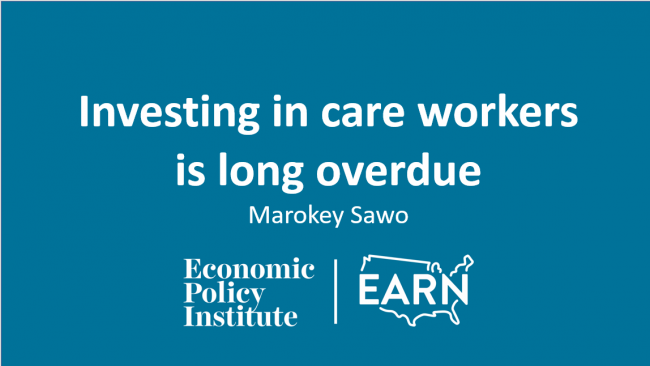
Overview of presentation
What do common care jobs look like?
Themes in current U.S. paid care economy
- Low pay and benefits
- Demanding work
- Twin conditions of care services being expensive yet care jobs paying very low wages
- Care jobs are vital for the survival and wellbeing of many yet have poor working conditions and pay
Current wages of care workers
- Average hourly wage of home health care workers: $13.81
- Average hourly wage of child care workers: $13.51
These conditions are pressing in Kentucky
- Share of long-term services and supports direct care workers in KY who make below $15/hour: 80.4%
– National average: 49.9%
- Share of child care workers in Kentucky who make below $15/hour: 78.8%
– National average: 43.5%
Why are care workers deeply undervalued and underpaid?
- Devaluation of care work occurs across three related axes. We devalue:
– Care work itself
– The people who primarily do care work
– Those most dependent on their labor
Who care workers are
Care workers are disproportionately women of color: Share of workers for all workers, home care workers, and child care workers, by selected demographics
| Men | White women | Black women | Hispanic women | AAPI women | Women of other race/ethnicity | |
|---|---|---|---|---|---|---|
| All workers | 53.1% | 29.1% | 6.4% | 7.5% | 3.3% | 0.5% |
| Home health care workers | 11.4% | 34.0% | 26.1% | 20.1% | 7.0% | 1.4% |
| Child care workers | 6.0% | 53.1% | 14.1% | 22.3% | 3.3% | 1.2% |
Note: To ensure sufficient sample sizes, this figure draws from pooled 2018–2020 microdata. AAPI refers to Asian American/Pacific Islander. Race/ethnicity categories are mutually exclusive (i.e., white non-Hispanic, Black non-Hispanic, AAPI non-Hispanic, and Hispanic any race).
Source: Economic Policy Institute (EPI) analysis of Current Population Survey basic monthly microdata, EPI Current Population Survey Extracts, Version 1.0.18 (2021), https://microdata.epi.org.
Care workers are disproportionately immigrant women: Breakdown of all workers, home health care workers, and child care workers by gender and citizenship status
| Men | U.S.-born women | Naturalized women | Noncitizen women | |
|---|---|---|---|---|
| All workers | 53.1% | 39.6% | 4.0% | 3.3% |
| Home health care workers | 11.4% | 62.1% | 13.9% | 12.6% |
| Child care workers | 6.0% | 73.3% | 9.8% | 10.9% |
Source: Economic Policy Institute (EPI) analysis of Current Population Survey basic monthly microdata, EPI Current Population Survey Extracts, Version 1.0.18 (2021), https://microdata.epi.org.
History of paid care economy in the U.S.
- Slavery and subsequent discriminatory policymaking continue to shape the current care economy
Policy solutions
We must lay out the mechanisms through which systems of oppression drive outcomes
We must increase the pay of care workers
Reducing penalties and improving wages in the home health care and child care sectors: Excerpt of benchmarks for setting wage standards for care workers
| Home health care workers | Child care workers | |
|---|---|---|
| Current average wage | $13.81 | $13.51 |
| Reducing pay disparities | ||
| Reducing care penalties | $15.74 | $15.47 |
| Reducing demographic penalties | $20.20 | $19.87 |
| Add union premium | $22.26 | $21.90 |
Notes: Wages are based on pooled 2018 to 2020 microdata from the Economic Policy Institute’s extracts of the Current Population Survey, reported in 2020 dollars.
Source: Economic Policy Institute (EPI) analysis of Current Population Survey Outgoing Rotation Group (ORG) microdata, EPI Current Population Survey Extracts, Version 1.0.18 (2021), https://microdata.epi.org.
Key commonalities among countries with better care provision
- Collective bargaining
- Universal coverage for care services
- State involvement in both funding care provision and oversight of workforce